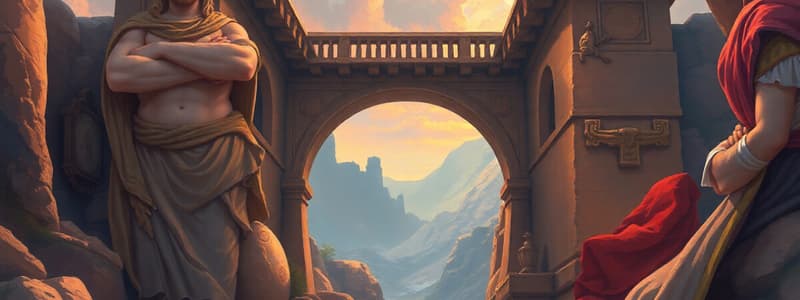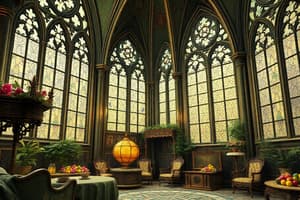Podcast
Questions and Answers
What distinguishes art from nature according to the content?
What distinguishes art from nature according to the content?
- Art is a natural occurrence.
- Art is always found in nature.
- Art is a direct representation of nature.
- Art is an individual's interpretation of nature. (correct)
Why is experiencing art described as highly personal and subjective?
Why is experiencing art described as highly personal and subjective?
- Personal tastes and biases affect how art is perceived. (correct)
- Art derives meaning solely from its historical context.
- Artworks are designed to be appreciated by everyone equally.
- Experience with art is based on factual information.
What is necessary in order to truly understand an artwork according to the content?
What is necessary in order to truly understand an artwork according to the content?
- Immersing oneself in the artwork. (correct)
- Receiving a formal art education.
- Reading critiques from art experts.
- Being knowledgeable about art history.
What role do emotions play in experiencing art as described in the content?
What role do emotions play in experiencing art as described in the content?
How is the evaluation of art characterized in the content?
How is the evaluation of art characterized in the content?
What does the word 'art' derive from in Ancient Latin?
What does the word 'art' derive from in Ancient Latin?
How did the definition of art change during the Renaissance Period?
How did the definition of art change during the Renaissance Period?
What distinguishes fine arts from useful arts?
What distinguishes fine arts from useful arts?
What concept evolved in the 17th century regarding art?
What concept evolved in the 17th century regarding art?
In what way did early man express himself through art?
In what way did early man express himself through art?
What is a key characteristic of art mentioned in the content?
What is a key characteristic of art mentioned in the content?
Which of the following is NOT listed in the assumptions of art?
Which of the following is NOT listed in the assumptions of art?
What aspect of art has been enjoyed by people continuously according to the provided information?
What aspect of art has been enjoyed by people continuously according to the provided information?
Flashcards
Art is Universal
Art is Universal
Art is timeless and exists everywhere, spanning generations and countries. It is a common expression that transcends time, place, and origin.
Art Involves Experience
Art Involves Experience
Art is created by humans as a way to express their feelings, thoughts, and ideas. It's a reflection of our inner world and how we understand the world around us.
Art is not nature
Art is not nature
Art is not simply a product of nature, but something created by humans. It's not found in the natural world as is, but rather born from human intention and skill.
Art vs. Nature
Art vs. Nature
Signup and view all the flashcards
Subjectivity in Art
Subjectivity in Art
Signup and view all the flashcards
Emotions in Art
Emotions in Art
Signup and view all the flashcards
Study Notes
Lesson 1: What is Art? Introduction and Assumptions
- The word "art" originates from the Ancient Latin "ars," meaning "craft or specialized form of skill."
- "Art" suggests the ability to produce a desired outcome through carefully planned steps or methods.
- Ancient civilizations used art primarily for functional purposes, producing objects useful for daily life.
- Medieval Latin broadened the definition of "art" to include forms of learning such as grammar, logic, magic, and astrology.
- The Renaissance marked a shift in perception. Early Renaissance artists began to view their work as craftsmanship rather than solely functional art.
- The 17th century saw the separation of aesthetic considerations (study of beauty) from technical skills.
- The concept of "fine arts" emerged, differentiating between fine art (beautiful art) and useful art.
- This evolved into the modern understanding of art.
Assumptions of Art
- Art is Universal: Art spans generations and continents; it exists in every culture and time period. People across cultures create and appreciate art, indicating a universal human need for expression.
- Art is not Nature: Art is a human interpretation and creation, distinct from natural phenomena. It's a way of expressing human perceptions of the world, not simply mimicking nature.
- Art involves Experience: Art is fundamentally experiential, not simply a collection of facts or information. Appreciating art involves actively engaging with it, immersing oneself in the artwork, and personal interpretation. Subjectivity and individual responses are central to understanding art. Personal taste, biases, and inner experiences greatly influence artistic appreciation. Experiences with art often elicit emotions and feelings.
Studying That Suits You
Use AI to generate personalized quizzes and flashcards to suit your learning preferences.



